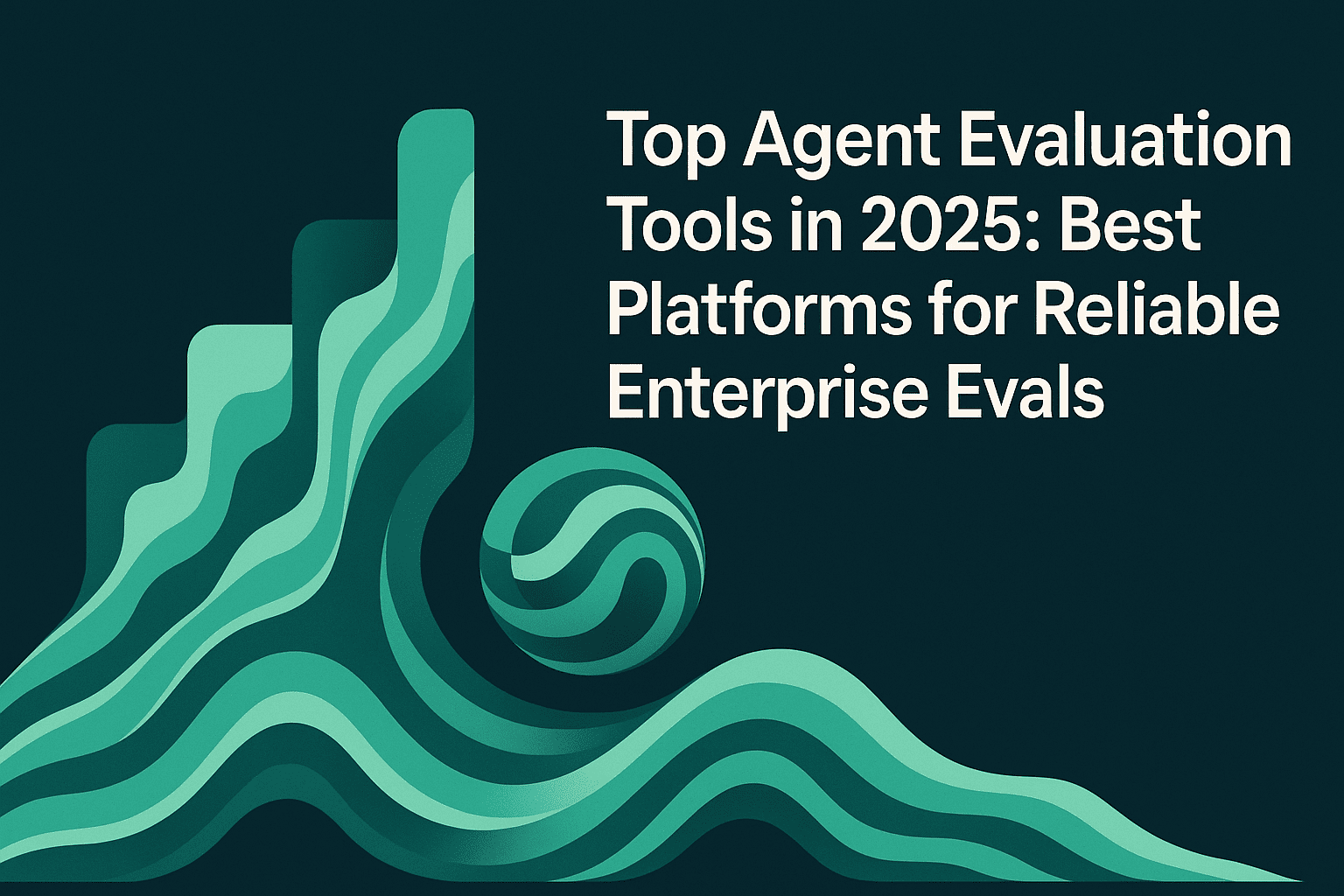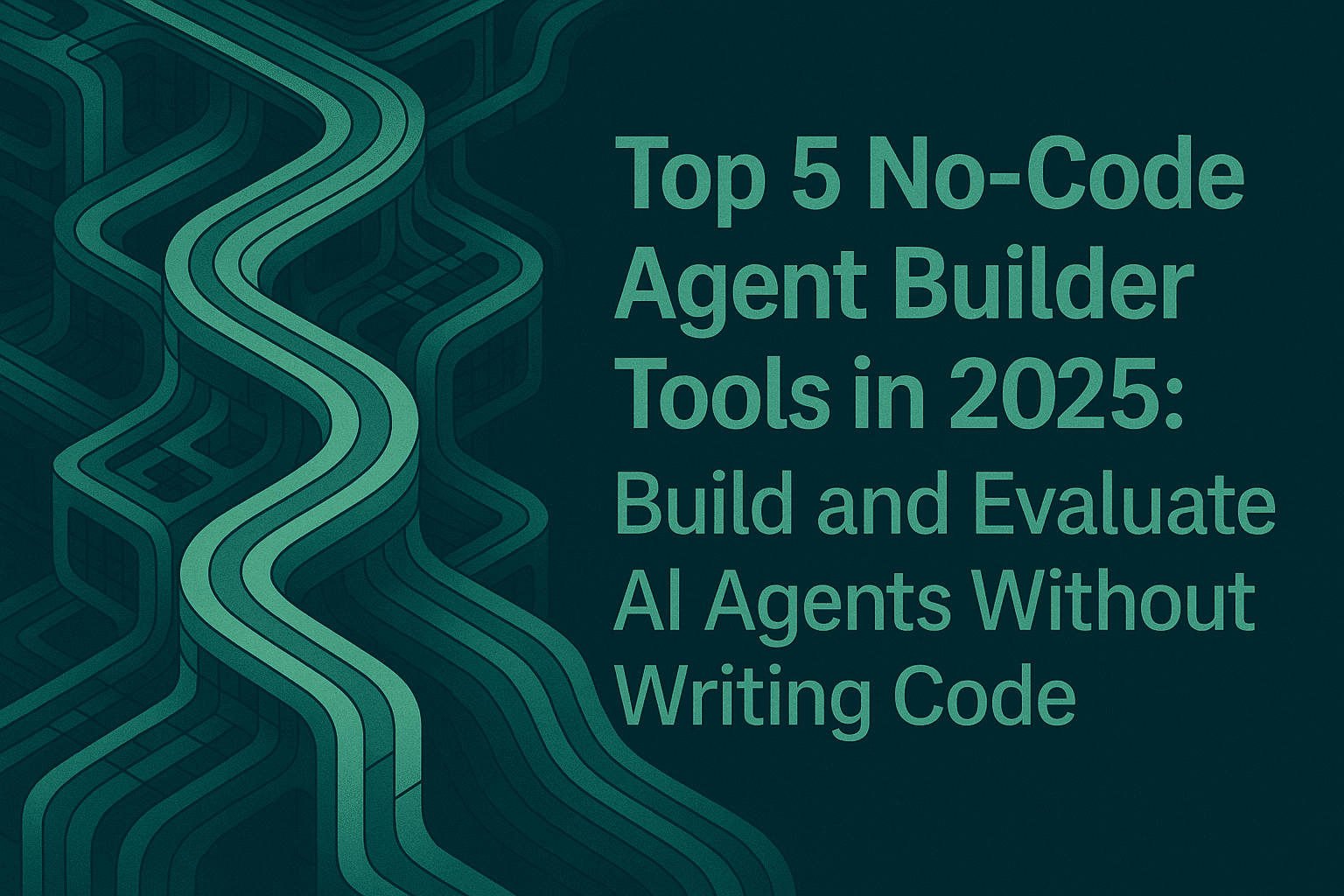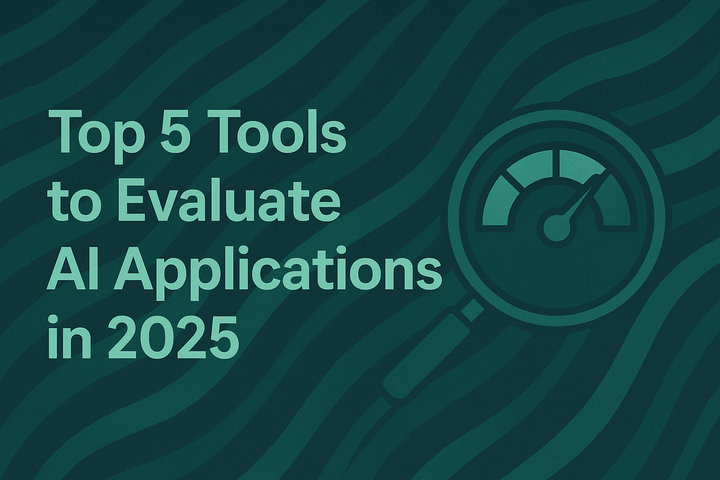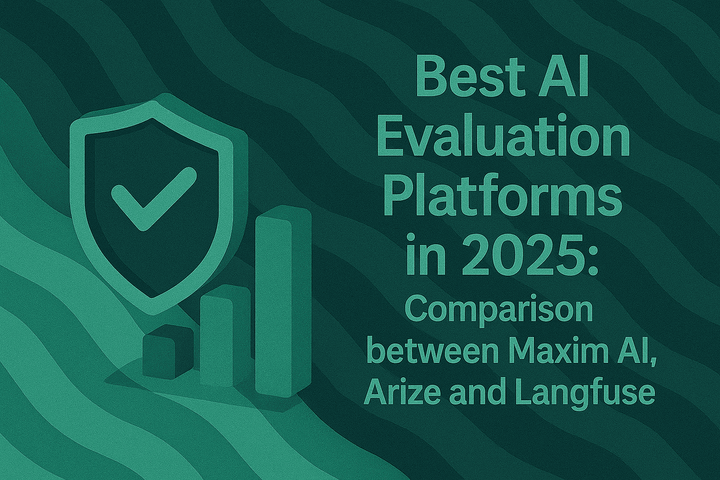Top Agent Evaluation Tools in 2025: Best Platforms for Reliable Enterprise Evals

TL;DR
Evaluating AI agents in 2025 requires platforms that can simulate multi-turn interactions, check whether agents make correct tool calls, and test how well they handle and recover from errors during a task. Leading platforms such as Maxim AI, LangSmith, Langfuse, Arize Phoenix, Comet, Confident AI, and RAGAS differ in their simulation depth, monitoring capabilities, dataset operations, and deployment models. When choosing a platform, prioritize full-lifecycle coverage (Experiment → Simulate & Evaluate → Observe), OpenTelemetry-based tracing for agent and tool actions, human-in-the-loop review flows, and enterprise features like RBAC, SSO, and in-VPC deployment.
Quick comparison: Top agent evaluation tools in 2025
| Tool | Best For | Deployment | Pricing | Open Source | Enterprise Ready | Simulation |
|---|---|---|---|---|---|---|
| Maxim AI | End-to-end enterprise lifecycle | SaaS / On-prem | Free / Custom | ❌ | ✅ SOC2, HIPAA, VPC | ✅ |
| LangSmith | LangChain workflows | SaaS | Paid | ❌ | ⚠️ Limited RBAC | ⚠️ |
| Langfuse | Self-hosted observability | Cloud / Self-host | Free / Paid | ✅ | ⚠️ Self-manage security | ⚠️ |
| Arize Phoenix | ML + Agent observability | Cloud | Free tier | ✅ | ✅ Enterprise plans | ⚠️ |
| Comet | Experiment tracking | Cloud | Paid | ❌ | ✅ Enterprise ready | ⚠️ |
| Confident AI | Dataset curation & quality | SaaS | Free / Paid | ✅ (DeepEval) | ⚠️ Growing | ⚠️ |
| RAGAS | RAG pipeline evaluation | Package | Free | ✅ | ❌ Framework only | ❌ |
✅ Supported ⚠️ Limited ❌ Not supported (as of Oct 2025)
What Enterprise AI Evals Actually Involve
Agents are systems that plan, call tools, and adapt when tools fail or return unexpected results, so evaluation must cover the end-to-end agent lifecycle: design and experiment with workflows, simulate realistic multi-turn journeys (including tool calls and failure modes), and instrument production with traces and reviewer queues to surface regressions and safety issues.
Treat evaluation as a loop:
Experiment
- Iterate prompts and agentic workflows with versioning and side-by-side comparisons.
- Validate structured outputs and tool-calling behavior.
- Balance quality, latency, and cost across models and parameters.
Evaluate
- Run offline evaluations for prompts or full workflows using synthetic and production-derived datasets.
- Simulate multi-turn personas and tool usage to reflect real user journeys.
- Orchestrate human evaluation for last-mile quality on dimensions like faithfulness, bias, safety, tone, and policy adherence.
Observe
- Sample production agent sessions for online evals; set alerts on regressions.
- Instrument distributed tracing for model and tool spans (OTel) to surface root causes.
- Mine failures into datasets for targeted offline re-runs and fine-tuning.
A strong platform lets teams move fluidly across layers: ship an agent, observe issues, mine logs into datasets, run targeted offline evals, fix, redeploy, and validate improvements in production.
How To Choose An Enterprise Agent Evaluation Platform
Use the following criteria to assess:
Breadth of Evaluation Methods
- Trajectory metrics: step completion, task success rate, tool-call accuracy, and replayable traces.
- Support for multi-turn persona simulation and action-level evaluators.
- Scalable human-in-the-loop review workflows and audit trails.
Production Alignment
- Online evals on sampled production traffic, real-time alerts, and distributed tracing (model + tool spans).
- Compatibility with OpenTelemetry and forwarding to your observability platforms.
Dataset Operations
- Curation from production logs, dataset versioning, metadata tagging, and repeatable sampling strategies.
- Export paths for BI tools and model fine-tuning.
Integrations and Extensibility
- Works with agent frameworks such as LangGraph, OpenAI Agents SDK, Crew AI, and others.
- SDK-first design, CI/CD gates, and flexible evaluator authoring.
Enterprise Controls and Scalability
- RBAC, SSO, in-VPC options, and SOC 2 Type 2 posture.
- Rate limits and cost visibility for high traffic workloads.
Reporting and Collaboration
- Side-by-side run comparisons, latent failure dashboards, reviewer summaries, and shareable reports for product/ops teams.
The Top 7 Agent Evaluation Tools For Enterprises In 2025
Below are platforms enterprises frequently evaluate for agentic systems and related LLM use cases. Each excels in specific contexts.
1) Maxim AI
✅ Best for: End-to-end enterprise AI evaluation lifecycle
Maxim AI is purpose-built for organizations that need unified, production-grade end-to-end simulation, evaluation, and observability for AI-powered applications. Maxim's platform is designed for the full agentic lifecycle, from prompt engineering, simulation, and evaluations (online and offline) to real-time monitoring for your applications so that your AI applications deliver a superior user experience to your end users.
Key Features
- Agent Simulation & Multi-Turn Evaluation: Test agents in realistic, multi-step scenarios, including tool use, multi-turn interactions, and complex decision chains.
- Prompt Management: Centralized CMS with versioning, visual editors, and side-by-side prompt comparisons. Maxim's Prompt IDE enables you to iterate on your prompts, run experiments, and A/B test different prompts in production.
- Automated & Human-in-the-Loop Evals: Run evaluations on end-to-end agent quality and performance using a suite of pre-built or custom evaluators. Build automated evaluation pipelines that integrate seamlessly with your CI/CD workflows. Maxim supports scalable and seamless human evaluation pipelines alongside auto evals for last-mile performance enhancement.
- Granular Observability: Node-level tracing with visual traces, OTel compatibility, and real-time alerts for monitoring production systems. Support for all leading agent orchestration frameworks, including OpenAI, LangGraph, and Crew AI. Easily integrate Maxim's monitoring tools with your existing systems.
- Enterprise Controls: SOC2, HIPAA, ISO27001, and GDPR compliance, fine-grained RBAC, SAML/SSO, and audit trails.
- Flexible Deployment: In-VPC hosting, usage-based, and seat-based pricing to fit teams of all sizes, whether you are a large enterprise or a scaling team.
Unique Strengths
- Highly performant SDKs for Python, TS, Java, and Go for a superior developer experience with integrations for all leading agent orchestration frameworks
- Enables seamless collaboration between Product and Tech teams to build and optimize AI applications with superior developer experience and super intuitive UI, acting as a driver for cross-functional collaboration and speed
- Enables product teams to run evals directly from the UI effectively, whether they are running evals on prompts or for an agent built in Maxim's No-Code agent builder, or any other no-code platform that they want to test
- Agent simulation enables you to simulate real-world interactions across multiple scenarios and personas rapidly
- Real-time alerting with Slack/PagerDuty integration
- Comprehensive evals and human annotation queues to evaluate your agents across qualitative quality and performance metrics using a suite of pre-built or custom evaluators
Enterprise Fit
- Integrations with LangGraph, OpenAI, OpenAI Agents, Crew AI, Anthropic, Bedrock, Mistral, LiteLLM, and more.
- Controls for RBAC, SSO, in-VPC deployment, SOC 2 Type 2, and priority support.
- Pricing tiers are designed for individual builders up to large enterprises. See Pricing.
Representative Use Cases
- Customer support copilots with policy adherence, tone control, and accurate escalation to human agents when required.
- Document processing agents with strict auditability and PII management.
- Voice and real-time agents require low-latency spans and robust error handling across tools.
Learn More
Explore the docs and product pages above, and review case studies like Shipping Exceptional AI Support: Inside Comm100's Workflow.
2) LangSmith
✅ Best for: LangChain and LangGraph workflows
LangSmith provides evaluation and tracing aligned with LangChain and LangGraph stacks. It is often adopted by teams building agents primarily in that ecosystem.
Where It Fits
- Tight integration for LangChain experiments, dataset-based evaluation, and run tracking.
- Familiar developer experience for LangChain-native teams.
Considerations
- Enterprises often add capabilities for human review, persona simulation, and online evals at scale.
- Validate enterprise controls, like in-VPC and granular RBAC, against your requirements. For reference comparisons, see Maxim vs LangSmith.
Best Use Cases
- Teams with LangChain-heavy workflows and moderate complexity.
- Projects where dataset-based checks and chain-level tracing are primary needs.
- Learn more: LangSmith Documentation
3) Langfuse
✅ Best for: Self-hosted observability and analytics
Langfuse is an open-source tool for agent observability and analytics that offers tracing, prompt versioning, dataset creation, and evaluation utilities.
Where It Fits
- Engineering-forward teams that prefer self-hosting and building custom pipelines.
- Organizations that want full control over where their data is stored and processed.
Considerations
- Self-hosting increases operational responsibility for reliability, security, and scaling.
- Enterprises often layer additional tools for multi-turn persona simulation, human review, and online evals. See Maxim vs Langfuse.
Best Use Cases
- Platform teams building a bespoke AI ops stack.
- Regulated environments where strong internal control over data is mandatory and in-house ops is acceptable.
- Learn more: Langfuse Documentation
4) Arize Phoenix
✅ Best for: ML and Agent hybrid observability
Arize Phoenix focuses on observability for ML and agent-driven systems, offering evaluation, tracing, and robust analytics for drift, slices, and data diagnostics.
Where It Fits
- Organizations with mature ML observability that want to extend analytics to agent behavior and multi-stage pipelines.
- Teams that rely on exploratory data analysis and deep data slicing for quality and drift investigations.
Considerations
- Validate depth for agent-centric simulations, human eval orchestration, and online evals on production traffic. See Maxim vs Arize Phoenix.
Best Use Cases
- Hybrid ML + agent estates that want a single observability lens for both models and agent workflows.
- Learn more: Arize Phoenix Documentation
5) Comet
✅ Best for: Experiment tracking and model management
Comet is well-known for experiment tracking and model/experiment governance, with expanding support for agent-related artifacts and prompt/workflow lineage.
Where It Fits
- Enterprises already using Comet for ML experiments that want to track agent artifacts, prompt versions, and experiment lineage.
- Teams standardizing governance, reproducibility, and audit trails across model and agent experiments.
Considerations
- For agentic applications with complex tool use and personas, validate the depth of simulation, human eval workflow, and online eval support. See Maxim vs Comet.
Best Use Cases
- Research-to-production pipelines that rely on centralized governance and lineage.
6) Confident AI
✅ Best for: Dataset quality and evaluation metrics
Confident AI, powered by DeepEval, is focused on building high-quality evaluator suites and dataset management. useful when you need trusted metrics for agent trajectories and RAG verification.
Key Features
- Battle-Tested Metrics: Powered by DeepEval (20M+ evaluations run), covering RAG, agents, and conversations
- Dataset Management: Non-technical domain experts can annotate and edit datasets on the platform
- Production Monitoring: Turn on evaluators for sampled sessions, filter unsatisfactory responses, and create curated datasets from production failures.
- Developer Experience: Simple SDK integration with quick evaluation setup
Where It Fits
- Teams prioritizing metric accuracy and transparency (open-source framework)
- Organizations needing strong dataset curation workflows
- Projects requiring production data to continuously improve test sets
Considerations
- Less comprehensive for full enterprise controls compared to Maxim (growing enterprise features)
- Strong in evaluation and monitoring, but lighter on full lifecycle management (experimentation, deployment)
Best Use Cases
- RAG applications requiring robust retrieval and generation metrics
- Teams are building evaluation datasets from production feedback
- Organizations wanting verified, community-trusted evaluation metrics
- Learn more: Confident AI Platform | DeepEval GitHub
7) RAGAS
✅ Best for: RAG pipeline evaluation
RAGAS is a focused open-source package for evaluating retrieval-augmented generation (RAG) systems - ideal where retrieval quality is critical for agent outputs.
Key Features
- RAG-Specific Metrics: Context precision, context recall, faithfulness, response relevancy, and noise sensitivity
- Lightweight Integration: Straightforward to integrate into existing workflows without extensive setup
- Framework Compatibility: Works with LlamaIndex, LangChain, and other RAG frameworks
Where It Fits
- Projects where retrieval quality directly affects agent correctness and groundedness.
- Teams that want a lightweight evaluation package to complement a full platform
Considerations
- It’s a package (not a full SaaS platform): you’ll need additional tooling for experiment tracking, reviewer queues, and online monitoring.
Best Use Cases
- Evaluating retrieval quality and generation accuracy in RAG applications
- Quick evaluation setup for RAG prototypes
- Teams are comfortable building their own evaluation infrastructure around the package
- Learn more: RAGAS Documentation
Best Agent Evaluation Tools by Use Case
For RAG Applications
- Primary: RAGAS (specialized metrics), Confident AI (dataset quality)
- Alternative: Maxim AI (full lifecycle), Arize Phoenix (observability)
For Agent Workflows
- Primary: Maxim AI (multi-turn simulation), LangSmith (LangChain native)
- Alternative: Langfuse (custom pipelines)
For Production Monitoring
- Primary: Maxim AI (online evals + alerts), Arize Phoenix (drift detection)
- Alternative: Confident AI (metric monitoring), Langfuse (self-hosted tracing)
For Enterprise Compliance
- Primary: Maxim AI (SOC2, HIPAA, VPC), Comet (governance)
- Alternative: Arize Phoenix (enterprise plans)
For Open-Source Flexibility
- Primary: Langfuse (full platform), RAGAS (evaluation package)
- Alternative: DeepEval via Confident AI (framework + platform)
Feature Comparison At A Glance
Top Agent Evaluation tools in 2025: Maxim, LangSmith, Langfuse, Arize Phoenix, Comet, Confident AI, and RAGAS compared for enterprise readiness, integrations, and best-fit use cases.
| Capability | Maxim AI | LangSmith | Langfuse | Arize Phoenix | Comet | Confident AI | RAGAS |
|---|---|---|---|---|---|---|---|
| Workflow & Prompt IDE | Yes, versioning, comparisons, structured outputs, tool support, workflow builder. See Experimentation. | Yes, strong in LangChain contexts. | Yes, via open-source components. | Partial; focused on observability rather than workflow building. | Yes, emerging support for prompt tracking and experiment lineage at model level. | Partial; focused on dataset testing and metric evaluation (no full workflow IDE). | No (package only). |
| Agent Simulation And Persona Testing | Yes, multi-turn, scalable, custom scenarios and personas. See Agent Simulation and Evaluation. | Limited; stronger in dataset-based evals. | Custom build required. | Partial; strong observability but limited agent simulation depth. | Partial; no native agent simulation, focus on experiment tracking. | Limited. | No. |
| Pre-built and Custom Evaluators | Yes, evaluator store and custom metrics. | Yes for dataset-based checks. | Mostly custom. | Yes with observability-centric checks. | Yes; scope varies by setup. | Yes, DeepEval metrics. | Yes, RAG-specific. |
| Human Evaluation Pipelines | Built-in with managed options. | Limited; often requires glue. | Custom build. | Partial; validate capabilities. | Partial; validate capabilities. | Yes, annotation features. | No. |
| Online Evals On Production Data | Yes, sampling, alerts, dashboards. See Online Evaluation Overview. | Basic hooks; validate. | Requires custom infra. | Yes as part of observability. | Partial; validate. | Partial; supports offline and metric monitoring (no live sampling) | No. |
| Agent & Tool Tracing (OTel) | Yes, agent and tool spans with OTel compatibility. See Tracing Overview. | Strong for LangChain traces. | Yes with self-host flexibility. | Yes, observability focus. | Partial; validate lineage. | Basic tracing. | No. |
| Dataset Curation From Logs | Yes, create datasets from production traces. | Partial. | Yes with engineering effort. | Yes. | Yes; process varies. | Strong; core feature. | No. |
| Enterprise Controls | RBAC, SSO, in-VPC, SOC 2 Type 2. See Pricing. | SSO and roles; validate in-VPC. | Self-host or managed; ops burden. | Enterprise-ready; validate specifics. | Enterprise-ready for ML governance; confirm agent-specific features. | Growing enterprise features; validate SOC/SSO coverage. | N/A (package only) |
| Integrations | OpenAI, OpenAI Agents, LangGraph, Anthropic, Bedrock, Mistral, LiteLLM, Crew AI, etc. | Deep with LangChain and LangGraph. | Flexible via code. | Broad observability integrations. | Broad ML ecosystem. | OpenAI, LlamaIndex, HuggingFace. | LlamaIndex, LangChain. |
A Reference Agent Evaluation Workflow
This seven-step loop works for consumer-facing agents, internal copilots, and document automation systems.
1. Start In A Prompt And Workflow IDE
Create or refine your prompt chain in an experimentation workspace with versioning and structured outputs. Compare variants across models and parameters.
Evaluator examples to add early: JSON Schema Validity, Instruction Following, Groundedness on a small seed dataset. See Experimentation and the Platform Overview.
2. Build A Test Suite And Run Offline Evals
Curate a dataset using synthetic examples plus prior production logs. Add task-specific evaluators and programmatic metrics. Run batch comparisons and gate promotion on thresholds.
Examples:
- Faithfulness score should average at least 0.80 on the support knowledge base dataset.
- JSON validity is at least 99 percent across 1,000 test cases.
- p95 latency under 1.5 seconds on a standard prompt chain.
- Cost per run under a defined target, depending on token pricing.
Get started with Agent Simulation and Evaluation.
3. Simulate Realistic Behavior
Go beyond single-turn checks. Simulate multi-turn conversations with tool calls, error paths, and recovery steps.
Personas to include: power user, first-time user, impatient user, compliance reviewer, and high-noise voice caller.
Evaluator examples: Escalation Decision Accuracy, Harmlessness and Safety, Tone and Empathy, Citation Groundedness.
4. Deploy With Guardrails And Fast Rollback
Version workflows and deploy the best-performing candidate. Decouple prompt and chain changes from application releases to enable fast rollback or A/B testing.
CI/CD tip: Gate deployment if any core evaluator drops more than 2 percentage points versus baseline or if p95 latency exceeds the SLO.
5. Observe In Production And Run Online Evals
Instrument distributed tracing with spans for model calls and tool invocations. Sample 5 to 10 percent of sessions for online evaluations.
Set alerts for faithfulness, policy adherence, latency, and cost deltas. Route alert notifications to the correct Slack channel or PagerDuty service. Learn more in Agent Observability, Tracing Overview, and Online Evaluation Overview.
6. Curate Data From Live Logs
Convert observed failures and edge cases into dataset entries. Refresh datasets weekly or per release.
Trigger human review when faithfulness falls below 0.70, when PII detectors fire, or when JSON validity fails. See exports and reporting in Agent Observability and the Test Runs Comparison Dashboard.
7. Report And Communicate
Use comparison dashboards to track evaluator deltas, cost per prompt, token usage, and latency histograms. Share reports with engineering, product, and CX stakeholders.
Promote configurations that show statistically significant improvements and stable production performance.
The Bottom Line
Agent evaluation is a system evaluation. Build a repeatable loop across experiment, simulation & evaluation, and observability; treat model checks as components inside trajectory scoring; and pick a platform that aligns with your deployment, governance, and scale needs.
For a unified loop across Experimentation, Simulation, Evaluation, and Observability, with enterprise-grade controls and integrations, consider Maxim AI. Review the product pages, docs, and case studies to see how teams use the full lifecycle in practice.
Ready to unify evaluation, simulation, and observability in one enterprise-grade stack?
Try Maxim AI free or book a demo to see how teams ship reliable AI faster.
FAQs
What Is The Difference Between Offline And Online Evals?
Offline evals run on curated datasets before release to quantify quality, safety, latency, and cost in controlled conditions. Online evals sample real production traffic and apply evaluators continuously to detect regressions and trigger alerts.
How Much Production Traffic Should Be Sampled For Online Evals?
Many teams start with 5 to 10 percent of sessions and adjust based on signal-to-noise ratios, evaluator cost, and incident trends. Ensure sampling captures both happy paths and edge cases.
Which Evaluators Should We Start With?
Common early evaluators include Faithfulness, Groundedness, Step Completion, JSON Schema Validity, Toxicity, Bias, and Cost Metrics. Add domain-specific checks like Escalation Decision Accuracy for support, or Field-Level Extraction Accuracy for document agents.
Should I Choose an Open-Source or Commercial Agent Evaluation Platform?
Open-source tools (Langfuse, RAGAS, DeepEval) offer transparency and flexibility but require operational overhead. Commercial platforms (Maxim AI, LangSmith, Confident AI) provide managed infrastructure, enterprise controls, and support.
Helpful Links To Go Deeper
Maxim Products And Docs
- Experimentation
- Agent Simulation and Evaluation
- Agent Observability
- Pricing
- Platform Overview
- Test Runs Comparison Dashboard
Maxim Articles And Guides
- AI Observability in 2025
- LLM Observability: Best Practices for 2025
- What Are AI Evals
- Agent Evaluation vs Model Evaluation
- Comm100 Case Study
Comparisons
Other Resources


